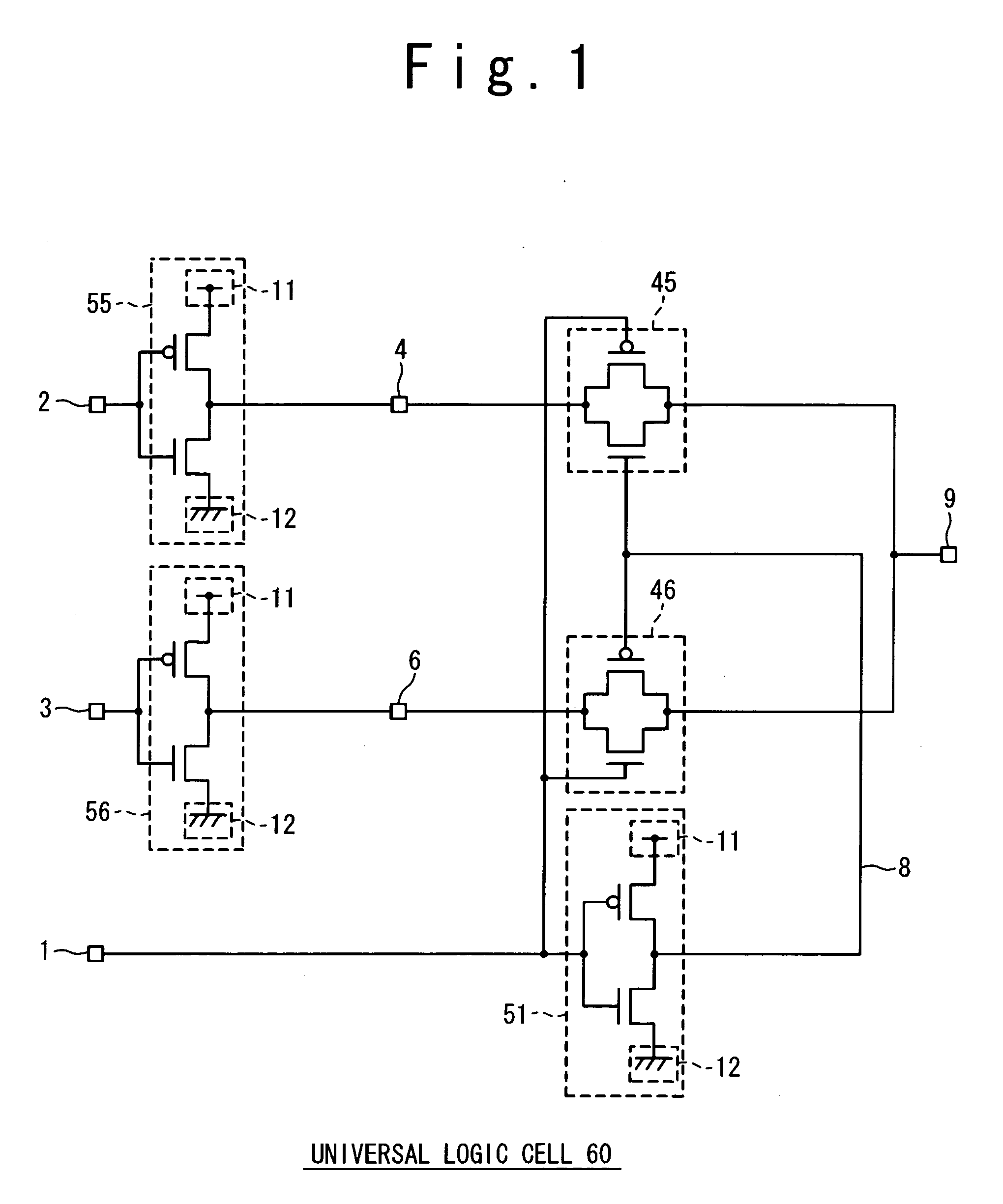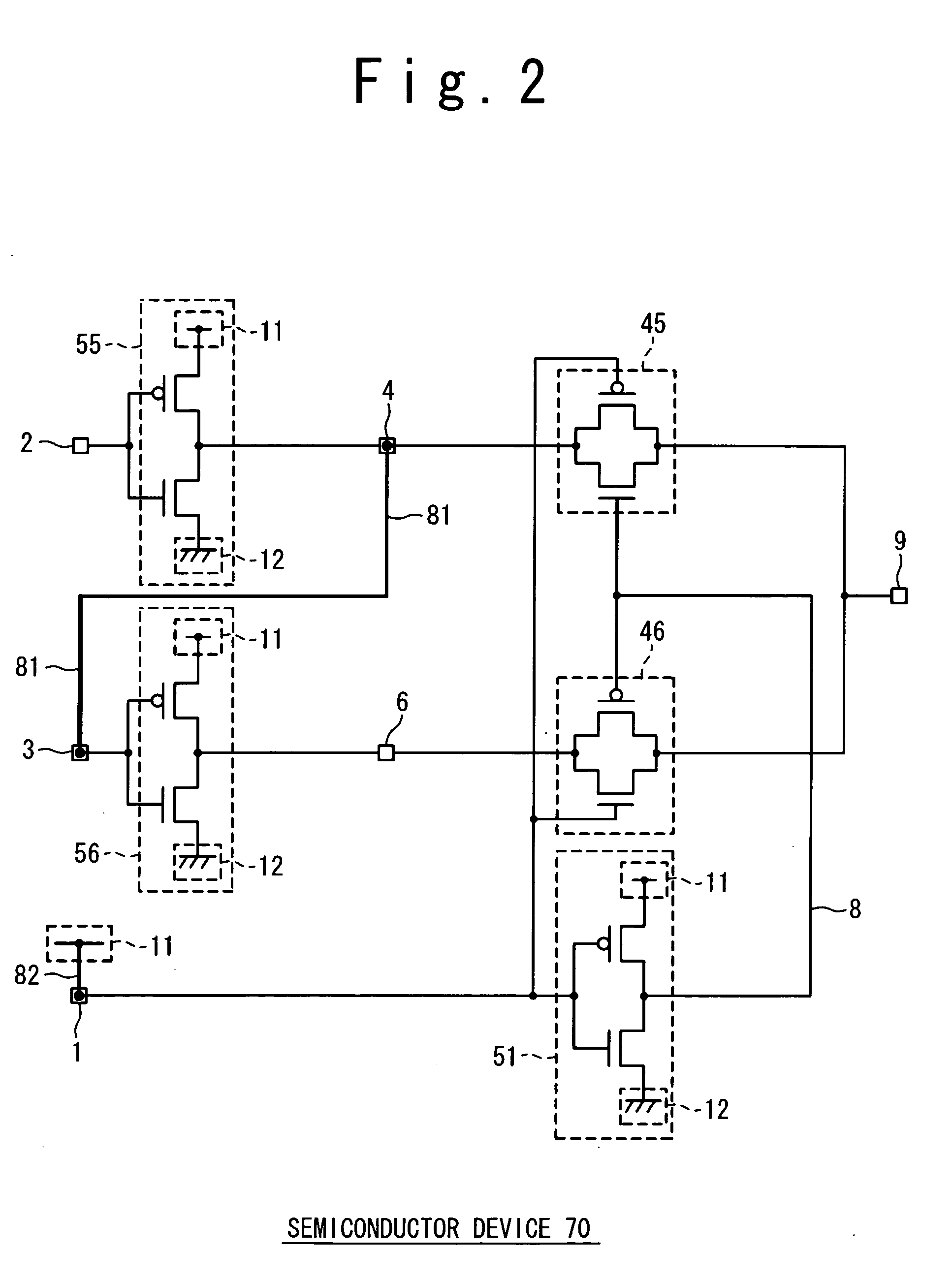Semiconductor device and manufacturing method of the same
a technology of semiconductors and semiconductors, applied in the direction of pulse techniques, instruments, computations using denominational number representations, etc., can solve the problem of longer delay time, and achieve the effect of reducing development costs, reducing power consumption, and efficient delay circuits
- Summary
- Abstract
- Description
- Claims
- Application Information
AI Technical Summary
Benefits of technology
Problems solved by technology
Method used
Image
Examples
first embodiment
[0038]FIG. 1 is a circuit diagram showing a configuration of a universal logic cell 60 according to a first embodiment of the present invention. The universal logic cell 60 has a first inverter 55 and a second inverter 56 in a first stage, and a first transfer gate 45 and a second transfer gate 46 in a second stage. The first transfer gate 45 and the second transfer gate 46 are connected to an inverter 51. In other words, the universal logic cell 60 forms a two-input and output-inversion-type multiplexer (MUX).
[0039] The inverter 51 is an inverter of a general type, having a P-channel transistor connected to a power supply line 11 and an N-channel transistor connected to a ground line 12. Here, the power supply line 11 and the ground line 12 are interconnections to be used to apply power supply potential VDD and ground potential GND, respectively. An input and an output of the inverter 51 are connected to a node 1 and a node 8, respectively.
[0040] The first inverter 55 is also an ...
second embodiment
[0048]FIG. 4 is a circuit diagram showing a configuration of a universal logic cell 60′ according to a second embodiment of the present invention. The universal logic cell 60′ includes P-channel transistors 21 and 22, N-channel transistors 31 and 32, transfer gates 41 to 44, and an inverter 51.
[0049] The inverter 51 is an inverter of a general type, having a P-channel transistor connected to a power supply line 11 and an N-channel transistor connected to a ground line 12. Here, the power supply line 11 and the ground line 12 are interconnections to be used to apply the power supply potential VDD and the ground potential GND, respectively. An input and an output of the inverter 51 are connected to a node 1 and a node 8, respectively.
[0050] A gate, a source and a drain of the P-channel transistor 21 are connected to a node 2, the power supply line 11 and a node 4, respectively. Also, a gate, a source and a drain of the N-channel transistor 31 are connected to the node 2, the ground ...
third embodiment
[0071] In a third embodiment of the present invention, the universal logic cell 60′ shown in FIGS. 4 to 7 is used as in the above-mentioned second embodiment. Therefore, description regarding the universal logic cell 60′ is omitted.
[0072]FIG. 9 is a circuit diagram showing a configuration of a semiconductor device 70B using the above-mentioned universal logic cell 60′ according to the present embodiment. The semiconductor device 70B shown in FIG. 9 has a first interconnection 81B and a second interconnection 82B in addition to the universal logic cell 60′ shown in FIG. 4. The first interconnection 81B and the second interconnection 82B are formed in the above-mentioned customize interconnection layers, and are connected with the exposed nodes and the ground line 12. More specifically, the first interconnection 81B connects the node 6, the node 7 and the node 2, while the second interconnection 82B connects the node 1 and the ground line 12. A method of manufacturing the semiconduct...
PUM
 Login to View More
Login to View More Abstract
Description
Claims
Application Information
 Login to View More
Login to View More - R&D
- Intellectual Property
- Life Sciences
- Materials
- Tech Scout
- Unparalleled Data Quality
- Higher Quality Content
- 60% Fewer Hallucinations
Browse by: Latest US Patents, China's latest patents, Technical Efficacy Thesaurus, Application Domain, Technology Topic, Popular Technical Reports.
© 2025 PatSnap. All rights reserved.Legal|Privacy policy|Modern Slavery Act Transparency Statement|Sitemap|About US| Contact US: help@patsnap.com



